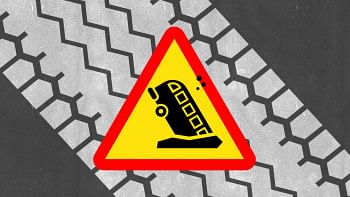Victims’ right to public law compensation

On 21 July, in a tragic aviation disaster, a training aircraft of the Bangladesh Air Force crashed into a two-storey academic building of Milestone School and College in Uttara, Dhaka, resulting in numerous casualties. A writ-petition has been filed with the High Court Division (HCD) of the Bangladesh Supreme Court seeking compensation for the deceased and injured. The court directed the government to form a committee to investigate into the incident and issued a rule asking why adequate compensation should not be provided to the victims.
Usually, when a fundamental right granted in the constitution is violated due to someone's negligence and the right-holder suffers due to the said violation, it raises a claim in constitutional tort. Consequently, the right-holder becomes entitled to receive compensation from the wrongdoer, which is popularly known as public law compensation.
In this piece, I argue that the incident of the training jet crash contains all the elements of a constitutional tort to establish the victims' right to public law compensation. According to Article 32 of the Constitution of Bangladesh, it is one of the constitutional duties of the state to uphold everyone's fundamental right to life, save in accordance with law. This constitutional duty was breached in the jet crash incident, resulting in severe casualties.
Although the words 'constitutional tort' or 'public law compensation' are not directly mentioned in the Constitution of Bangladesh, a careful analysis of the constitutional provisions can reveal that these ideas already exist within the constitution. Article 44(1) of the Constitution of Bangladesh guaranteed the right to move the HCD in accordance with Article 102(1), for the enforcement of the fundamental rights. Article 102(1) states that the HCD, on the application of any person aggrieved, may give such directions or orders to any person or authority as may be appropriate for the enforcement of any of the fundamental rights enshrined in the Constitution. Here, the word 'appropriate' provides a wide jurisdiction to the HCD to make 'any order' to 'any person', either state or individual, to enforce the fundamental rights. Therefore, the HCD is empowered by the Constitution to grant appropriate remedy, including compensation, for the violation of any fundamental right.
Additionally, the granting of public law compensation as a remedy has been in the judgments of the Supreme Court of Bangladesh. Bilkis Akter Hossain v Bangladesh (1997) was the pioneer case in this context, where the concept of public law compensation as a remedy was introduced by the HCD. However, the Appellate Division (AD) modified the lenient 'case-by-case' test to a stricter 'exceptional cases' test.
To establish tortious liability, it is usually necessary to prove the negligence of the responsible party. However, an exception to this rule is the principle of 'strict liability,' under which a party is held liable for a breach of duty irrespective of negligence.
The successful application of public law compensation further came up in the landmark case of CCB Foundation v Government of Bangladesh and others (2016), which is commonly known as the 'Jihad Case.' In this case, the HCD ordered Bangladesh Railway, and Bangladesh Fire Service and Civil Defence to compensate BDT 10 lakh each to the parents of the four-year-old boy, who died after falling into a deep shaft adjacent to the Shahjahanpur Railway Colony playground. The shaft was 16-inch-wide and more than a hundred feet deep and was left uncovered and unattended by the respondents. The AD upheld the decision of the HCD, thereby giving effect to the application of constitutional tort and public law compensation in Bangladesh.
In 2019, the HCD issued an order in favour of Russel Sarker, a car driver who lost his left leg after being run over by a Green Line bus. The court directed the company to compensate Rassel Sarker with BDT 50 lakh. This decision of the HCD was then upheld by the AD and consequently, widened the scope of the application of constitutional tort in Bangladesh by making a private party liable to public law compensation.
To establish tortious liability, it is usually necessary to prove the negligence of the responsible party. However, an exception to this rule is the principle of 'strict liability,' under which a party is held liable for a breach of duty irrespective of negligence. It is a worldwide recognised principle of tort law, which was established in the famous case of Rylands v Fletcher (1868). This legal concept is essential in cases where the activities pose inherent risks, regardless of the precautions taken. In this regard, even if we assume that there was no negligence on part of the responsible authorities in the jet crash incident, they still fall under the strict liability principle for the activities such as flying training aircrafts in the airspace of a densely populated urban area, setting up a public school so close to an international airport and directly in aircrafts' flight path, etc.
Where there is a right, there must be a remedy. It is a legal principle that comes from the Latin maxim ubi jus ibi remedium. Considering the maxim, it can be said that the existence of the right to life in Article 32 of the Constitution of Bangladesh itself opens the door to a remedy against its infringement.
The writer teaches law at Shanto-Mariam University of Creative Technology, Dhaka.

 For all latest news, follow The Daily Star's Google News channel.
For all latest news, follow The Daily Star's Google News channel. 



Comments